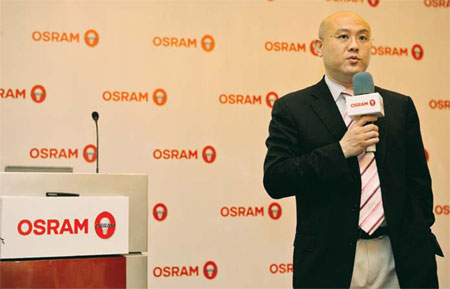Osram plans on a bright future
By Meng Jing (China Daily) Updated: 2012-09-15 15:24Germany-based company is investing heavily in China's LED market
When it comes to news about China's light-emitting diode industry, Osram AG Asia-Pacific President Samuel Wu is never in the dark. Since taking the helm of the regional operations of the world's second-largest lighting manufacturer in April, the former control engineer has eagerly devoured any news about the industry.
|
 Samuel Wu believes as LED technologies mature, the market will reward producers with top-tier technologies and high-quality products despite their relatively high prices. [Photo/China Daily] |
One tidbit that recently attracted his attention was an article about the LED industry in South China's Guangdong province.
"It said that almost all the LEDs priced below 30 yuan ($4.73) were shown to be faulty to some extent in a test by local authorities in Guangzhou," Wu says, adding that this is a sign the sector in China is at an early stage, filled with low-quality and low-price products.
However, the seemingly immature LED industry in China has not scared Osram away. In August, the Germany-based company sped up its expansion by breaking ground on its first-ever LED-assembly plant in China, three months after it announced an investment plan in Wuxi, in East China's Jiangsu province.
"China is already the largest lighting market in the world with a significant growth potential in LED lighting. With China's LED lighting sector heading to a much healthier direction in the future, the market will reward producers with top-tier technologies and high-quality products despite their relatively high prices," Wu says.
LEDs, powered as they are by semiconductors, are notable for their performance in terms of energy efficiency, life span and environmental friendliness.
As such, many scientists and companies say LEDs are set to transform the world's lighting industry.
Though China's LED market is going through a tough time, with news of LED-producers' bankruptcies and reduced sales frequently hitting headlines, Wu is a firm believer in a rosy future for his company's business.
Osram, the lighting subsidiary of the German conglomerate Siemens AG, does not only have more than 100 years of experience in providing lighting solutions but has also inherited around 8,000 LED patents, Wu says.
"There are plenty of players in LED lighting in China but few of them have mastered the key technologies of this sector. Our presence in China can fill the gap in the high end," he says.
The 100,000-square-meter Wuxi plant, which is scheduled for completion by the end of 2013, is Osram's fifth production base in China and the company's third LED production base worldwide, including its plants in Germany and Malaysia.
LED lighting is more accepted in developed countries due to its high price, but Wu emphasizes the new plant in Wuxi is in line with the company's "In China, for China" strategy.
He cites a recent market report from the global management-consulting firm McKinsey that said China's lighting market alone is worth more than 8 billion euros ($10 billion) today, which projected to more than double by 2020.
"The migration from conventional bulbs to LED lighting is a major driving force for the strong momentum in China," Wu says. He points out that China's LED-lighting sector is projected by McKinsey to be worth 11 billion euros by 2020, accounting for 20 percent of global revenue.
Wu refuses to disclose Osram's business performance in China or its share of the country's LED-lighting market as the company is on its way to a listing on a stock exchange scheduled for 2013. He does, however, reveal that one-fifth of the company's 5 billion euro revenue in 2011 was generated in the Asia-Pacific region, where it has more than 16,000 employees.
- Light maker Osram inaugurate Wuxi plant
- A green light for Osram
- Savings drive LED market in China
- Guangdong LED industry set for losses
- Innovation lights the way for only a few LED makers
- Sino-German benefits
- Germany remains most attractive target for investors
- China-Germany ties enhance business co-op
- China's coal-producing province to reform electricity pricing
- China to play unifier, innovator role with 'Belt and Road'
- First electricity trading centers open in Beijing and Guangzhou
- Mainland entrepreneurs sparking boom in startups
- Chinese manufacturing hub on front lines of robot revolution
- More pro-growth policies expected for China's economy
- RRR cut boosts property stocks
- Wenzhou whizzes take it easy in realty market
















